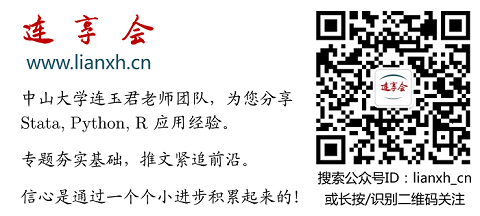
New! 搜推文,找资料,用
lianxh命令:
安装:ssc install lianxh, replace
使用:lianxh 合成控制
lianxh DID + 多期, w


倍分法 参考文献 (DID References)
Source: Callaway, B., P. H. Sant'Anna, 2020, Difference-in-differences with multiple time periods, arXiv preprint arXiv:1803.09015. -PDF-. Code to implement the methods proposed in the paper is
available in the R packagedidwhich is available on CRAN, CRAN-Tsinghua.
- Abadie, A. (2005), “Semiparametric difference-in-difference estimators,” Review of Economic Studies, 72, 1–19.
- Abadie, A., Athey, S., Imbens, G., and Wooldridge, J. (2017), “When should you adjust standard errors for clustering?,” Working Paper.
- Abbring, J. H., and van den Berg, G. J. (2003), “The nonparametric identification of treatment effects in duration models,” Econometrica, 71(5), 1491–1517.
- Athey, S., and Imbens, G. W. (2006), “Identification and inference in nonlinear difference in differences models,” Econometrica, 74(2), 431–497.
- Athey, S., and Imbens, G. W. (2018), “Design-based analysis in difference-in-differences settings with staggered adoption,” Working Paper.
- Bailey, M. J., and Goodman-Bacon, A. (2015), “The war on poverty’s experiment in public medicine: Community health centers and the mortality of older Americans,” American Economic Review, 105(3), 1067–1104.
- Belloni, A., Chernozhukov, V., Fern´andez-Val, I., and Hansen, C. (2017), “Program evaluation and causal inference with high-dimensional data,” Econometrica, 85(1), 233–298.
- Bertrand, M., Duflo, E., and Mullainathan, S. (2004), “How much should we trust differences-in-differences estimates?,” The Quarterly Journal of Economics, 119(1), 249–275.
- Bojinov, I., Rambachan, A., and Shephard, N. (2020), “Panel Experiments and Dynamic Causal Effects: A Finite Population Perspective,” Working Paper.
- Bonhomme, S., and Sauder, U. (2011), “Recovering distributions in difference-in-differences models: A comparison of selective and comprehensive schooling,” Review of Economics and Statistics, 93(May), 479–494.
- Borusyak, K., and Jaravel, X. (2017), “Revisiting event study designs,” Working Paper.
- Botosaru, I., and Gutierrez, F. H. (2018), “Difference-in-differences when the treatment status is observed in only one period,” Journal of Applied Econometrics, 33(1), 73–90.
- Busso, M., Dinardo, J., and McCrary, J. (2014), “New evidence on the finite sample properties of propensity score reweighting and matching estimators,” The Review of Economics and Statistics, 96(5), 885–895.
- Callaway, B., Li, T., and Oka, T. (2018), “Quantile treatment effects in difference in differences models under dependence restrictions and with only two time periods,” Journal of Econometrics, 206(2), 395–413.
- Card, D., and Krueger, A. B. (1994), “Minimum wages and employment: A case study of the fast-food industry in New Jersey and Pennsylvania,” American Economic Review, 84(4), 772–793.
- Chen, X., Hong, H., and Tarozzi, A. (2008), “Semiparametric efficiency in GMM models with auxiliary data,” The Annals of Statistics, 36(2), 808–843.
- Chen, X., Linton, O., and Van Keilegom, I. (2003), “Estimation of semiparametric models when the criterion function is not smooth,” Econometrica, 71(5), 1591–1608.
- Cheng, G., Yu, Z., and Huang, J. Z. (2013), “The cluster bootstrap consistency in generalized estimating equations,” Journal of Multivariate Analysis, 115, 33–47.
- Chernozhukov, V., Fern´andez-Val, I., Hahn, J., and Newey, W. (2013), “Average and quantile effects in nonseparable panel models,” Econometrica, 81(2), 535–580.
- Chernozhukov, V., Fern´andez-Val, I., and Luo, Y. (2017), “The sorted effects method: Discovering heterogeneous effects beyond their averages,” Working Paper.
- Conley, T., and Taber, C. (2011), “Inference with “difference in differences” with a small number of policy changes,” Review of Economics and Statistics, 93(1), 113–125.
- Crump, R. K., Hotz, V. J., Imbens, G. W., and Mitnik, O. A. (2009), “Dealing with limited overlap in estimation of average treatment effects,” Biometrika, 96(1), 187–199.
- de Chaisemartin, C., and D’Haultfœuille, X. (2017), “Fuzzy Differences-in-Differences,” The Review of Economic Studies, 85, 999–1028.
- de Chaisemartin, C., and D’Haultfœuille, X. (2020), “Two-way fixed effects estimators with heterogeneous treatment effects,” American Economic Review, .
- Dube, A., Lester, T. W., and Reich, M. (2010), “Minimum wage effects across state borders: Estimates using contiguous counties,” Review of Economics and Statistics, 92(4), 945–964.
- Dube, A., Lester, T. W., and Reich, M. (2016), “Minimum wage shocks, employment flows, and labor market frictions,” Journal of Labor Economics, 34(3), 663–704.
- Farber, H. S. (2017), “Employment, hours, and earnings consequences of job loss: US evidence from the displaced workers survey,” Journal of Labor Economics, 35(S1), S235–S272.
- Ferman, B., and Pinto, C. (2018), “Inference in differences-in-differences with few treated groups and heteroskedasticity,” The Review of Economics and Statistics, p. rest a 00759.
- Freyberger, J., and Rai, Y. (2018), “Uniform confidence bands: Characterization and optimality,” Journal of Econometrics, Forthcoming.
- Gibbons, C. E., Su´arez Serrato, J. C., and Urbancic, M. B. (2018), “Broken or Fixed Effects?,” Journal of Econometric Methods, 8(1).
- Goodman-Bacon, A. (2018), “Difference-in-differences with variation in treatment timing,” Working Paper.
- Graham, B., Pinto, C., and Egel, D. (2012), “Inverse probability tilting for moment condition models with missing data,” The Review of Economic Studies, 79(3), 1053–1079.
- H´ajek, J. (1971), “Discussion of ‘An essay on the logical foundations of survey sampling, Part I’, by D. Basu,” in Foundations of Statistical Inference, eds. V. P. Godambe, and D. A. Sprott, Toronto: Holt, Rinehart, and Winston.
- Han, S. (2019), “Identification in nonparametric models for dynamic treatment effects,” Journal of Econometrics, pp. 1–21.
- Heckman, J. J., Humphries, J. E., and Veramendi, G. (2016), “Dynamic treatment effects,” Journal of Econometrics, 191(2), 276–292.
- Heckman, J. J., Ichimura, H., Smith, J., and Todd, P. (1998), “Characterizing selection bias using experimental data,” Econometrica, 66(5), 1017–1098.
- Heckman, J. J., Ichimura, H., and Todd, P. (1997), “Matching as an econometric evaluation estimator: Evidence from evaluating a job training programme,” The Review of Economic Studies, 64(4), 605–654.
- Imai, K., Kim, I. S., and Wang, E. (2018), “Matching methods for causal inference with time-series cross-section data,” Working Paper.
- Khan, S., and Tamer, E. (2010), “Irregular Identification, Support Conditions, and Inverse Weight Estimation,” Econometrica, 78(6), 2021–2042.
- Kline, P., and Santos, A. (2012), “A score based approach to wild bootstrap inference,” Journal of Econometric Methods, 1(1), 1–40.
- Kosorok, M. R. (2008), Introduction to Empirical Processes and Semiparametric Inference, New York, NY: Springer.
- Laporte, A., and Windmeijer, F. (2005), “Estimation of panel data models with binary indicators when treatment effects are not constant over time,” Economics Letters, 88(3), 389–396.
- MacKinnon, J. G., and Webb, M. D. (2016), “Randomization inference for difference-in-differences with few treated clusters,” Working Paper.
- MacKinnon, J. G., and Webb, M. D. (2018), “The wild bootstrap for few (treated) clusters,” The Econometrics Journal, 21(2), 114–135.
- Malani, A., and Reif, J. (2015), “Interpreting pre-trends as anticipation: Impact on estimated treatment effects from tort reform,” Journal of Public Economics, 124, 1–17.
- Mammen, E. (1993), “Bootstrap and wild bootstrap for high dimensional linear models,” The Annals of Statistics, 21(1), 255–285.
- Marcus, M., and Sant’Anna, P. H. C. (2020), “The role of parallel trends in event study settings : An application to environmental economics,” Working Paper, pp. 1–48.
- McCrary, J. (2007), “The effect of court-ordered hiring quotas on the composition and quality of police,” American Economic Review, 97(1), 318–353.
- Meer, J., and West, J. (2016), “Effects of the minimum wage on employment dynamics,” Journal of Human Resources, 51(2), 500–522.
- Montiel Olea, J. L., and Plagborg-Møller, M. (2018), “Simultaneous confidence bands: Theory, implementation,
- and an application to SVARs,” Journal of Applied Econometrics, pp. 1–64.
- Murphy, S. A. (2003), “Optimal Dynamic Treatment Regimes,” Journal of the Royal Statistical Society Series B, 65(2), 331–366.
- Murphy, S. A., Van der Laan, M. J., Robins, J. M., Bierman, K. L., Coie, J. D., Greenberg, M. T., Lochman, J. E., McMahon, R. J., and Pinderhughes, E. (2001), “Marginal mean models for dynamic regimes,” Journal of the American Statistical Association, 96(456), 1410–1423.
- Neumark, D., and Wascher, W. (2000), “Minimum wages and employment: A case study of the fast-food industry in New Jersey and Pennsylvania: Comment,” American Economic Review, 90(5), 1362–1396.
- Neumark, D., and Wascher, W. L. (2008), Minimum Wages, Cambridge, MA: The MIT Press.
- Newey, W. K., and McFadden, D. (1994), “Large sample estimation and hypothesis testing,” in Handbook of Econometrics, Vol. 4, Amsterdam: North-Holland: Elsevier, chapter 36, pp. 2111–2245.
- Oreopoulos, P., von Wachter, T., and Heisz, A. (2012), “The short- and long-term career effects of graduating in a recession,” Applied Economics, 4(1), 1–29.
- Qin, J., and Zhang, B. (2008), “Empirical-likelihood-based difference-in-differences estimators,” Journal of the Royal Statistical Society. Series B (Methodological), 75(8), 329–349.
- Robins, J. (1987), “Addendum To ’A New Approach To Causal Inference in Mortality Studies With a Sustained Exposure Period - Application To Control of the Healthy Worker Survivor Effect’.,” Computers and Mathematics with Application, 14, 923–945.
- Robins, J. M. (1986), “A new approach To causal inference in mortality studies with a sustained exposure period - Application to control of the healthy worker survivor effect,” Mathematical Modelling, 7, 1393–1512.
- Roth, J. (2020), “Pre-test with caution: Event-study estimates after testing for parallel trends,” Working Paper, pp. 1–84.
- Rubin, D. B. (2007), “The design versus the analysis of observational studies for causal effects: Parallels with the design of randomized trials,” Statistics in Medicine, 26(1), 20–36.
- Rubin, D. B. (2008), “For objective causal inference, design trumps analysis,” Annals of Applied Statistics, 2(3), 808–840.
- Sant’Anna, P. H. C., and Song, X. (2019), “Specification tests for the propensity score,” Journal of Econometrics, 210, 379–404.
- Sant’Anna, P. H., and Zhao, J. (2020), “Doubly robust difference-in-differences estimators,” Journal of Econometrics, .
- Sherman, M., and Le Cessie, S. (2007), “A comparison between bootstrap methods and generalized estimating equations for correlated outcomes in generalized linear models,” Communications in Statistics - Simulation and Computation, 26(3), 901–925.
- Sianesi, B. (2004), “An evaluation of the Swedish system of active labor market programs in the 1990s,” The Review of Economics and Statistics, 86(1), 133–155.
- S loczy´nski, T. (2020), “Interpreting OLS estimands when treatment effects are heterogeneous: Smaller groups get larger weights,” Review of Economics and Statistics, .
- Sun, L., and Abraham, S. (2020), “Estimating dynamic treatment effects in event studies with heterogeneous treatment effects,” Working Paper.
- van der Vaart, A. W. (1998), Asymptotic Statistics, Cambridge: Cambridge University Press.
- van der Vaart, A. W., and Wellner, J. A. (1996), Weak Convergence and Empirical Processes, New York: Springer.
- Wooldridge, J. M. (2003), “Cluster-sample methods in applied econometrics,” American Economic Review P&P, 93(2), 133–138.
- Wooldridge, J. M. (2005a), “Fixed-effects and related estimators for correlated random-coefficient and treatmenteffect panel data models,” Review of Economics and Statistics, 87(2), 385–390.
- Wooldridge, J. M. (2005b), “Violating ignorability of treatment by controlling for too many factors,” Econometric Theory, 21(5), 1026–1028.
- Wooldridge, J. M. (2007), “Inverse probability weighted estimation for general missing data problems,” Journal of Econometrics, 141(2), 1281–1301.
- Yang, S., and Ding, P. (2018), “Asymptotic inference of causal effects with observational studies trimmed by the estimated propensity scores,” Biometrika, 105(2), 487–493.


资源共享
- 连享会资料 ……
- 在线视频:lianxh-class.cn
- Stata 33 讲,100 万+ 播放,Stata 入门必备,公开课
- 直击面板数据模型,10 万+ 播放,白话面板模型,公开课
- … more …
- 论文复现和数据
- 主题分类
- 热门推文

尊敬的老师 / 亲爱的同学们:
连享会致力于不断优化和丰富课程内容,以确保每位学员都能获得最有价值的学习体验。为了更精准地满足您的学习需求,我们诚挚地邀请您参与到我们的课程规划中来。
请您在下面的问卷中,分享您 感兴趣的学习主题或您希望深入了解的知识领域 。您的每一条建议都是我们宝贵的资源,将直接影响到我们课程的改进和创新。
我们期待您的反馈,因为您的参与和支持是我们不断前进的动力。感谢您抽出宝贵时间,与我们共同塑造更加精彩的学习旅程!https://www.wjx.cn/vm/YgPfdsJ.aspx# 再次感谢大家宝贵的意见!

关于我们
- Stata连享会 由中山大学连玉君老师团队创办,定期分享实证分析经验。more……
- 扫码加入连享会微信群,提问交流更方便


